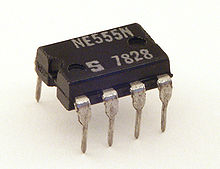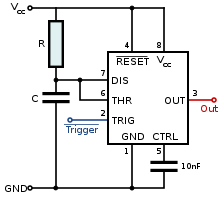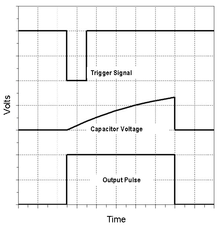- 555 timer IC
-
The 555 timer IC is an integrated circuit (chip) used in a variety of timer, pulse generation and oscillator applications. The part is still in widespread use, thanks to its ease of use, low price and good stability. As of 2003[update], it is estimated that 1 billion units are manufactured every year.[1]
Contents
Design
The IC design was proposed in 1970 by Hans R. Camenzind and Jim Ball. After prototyping, the design was ported to the Monochip analogue array, incorporating detailed design by Wayne Foletta and others from Qualidyne Semiconductors. Signetics (later acquired by Philips) took over the design and production, and released the first 555s in 1971.
Depending on the manufacturer, the standard 555 package includes over 20 transistors, 2 diodes and 15 resistors on a silicon chip installed in an 8-pin mini dual-in-line package (DIP-8).[2] Variants available include the 556 (a 14-pin DIP combining two 555s on one chip), and the 558 (a 16-pin DIP combining four slightly modified 555s with DIS & THR connected internally, and TR is falling edge sensitive instead of level sensitive).
The NE555 parts were commercial temperature range, 0 °C to +70 °C, and the SE555 part number designated the military temperature range, −55 °C to +125 °C. These were available in both high-reliability metal can (T package) and inexpensive epoxy plastic (V package) packages. Thus the full part numbers were NE555V, NE555T, SE555V, and SE555T. It has been hypothesized that the 555 got its name from the three 5 kΩ resistors used within,[3] but Hans Camenzind has stated that the number was arbitrary.[1]
Low-power versions of the 555 are also available, such as the 7555 and CMOS TLC555.[4] The 7555 is designed to cause less supply glitching than the classic 555 and the manufacturer claims that it usually does not require a "control" capacitor and in many cases does not require a decoupling capacitor on the power supply. Such a practice should nevertheless be avoided, because noise produced by the timer or variation in power supply voltage might interfere with other parts of a circuit or influence its threshold voltages.
Usage
Pins
The connection of the pins for a DIP package is as follows:
Pin Name Purpose 1 GND Ground, low level (0 V) 2 TRIG OUT rises, and interval starts, when this input falls below 1/3 VCC. 3 OUT This output is driven to +VCC or GND. 4 RESET A timing interval may be interrupted by driving this input to GND. 5 CTRL "Control" access to the internal voltage divider (by default, 2/3 VCC). 6 THR The interval ends when the voltage at THR is greater than at CTRL. 7 DIS Open collector output; may discharge a capacitor between intervals. 8 V+, VCC Positive supply voltage is usually between 3 and 15 V. Modes
The 555 has three operating modes:
- Monostable mode: in this mode, the 555 functions as a "one-shot" pulse generator. Applications include timers, missing pulse detection, bouncefree switches, touch switches, frequency divider, capacitance measurement, pulse-width modulation (PWM) and so on.
- Astable – free running mode: the 555 can operate as an oscillator. Uses include LED and lamp flashers, pulse generation, logic clocks, tone generation, security alarms, pulse position modulation and so on. Selecting a thermistor as timing resistor allows the use of the 555 in a temperature sensor: the period of the output pulse is determined by the temperature. The use of a microprocessor based circuit can then convert the pulse period to temperature, linearize it and even provide calibration means.
- Bistable mode or Schmitt trigger: the 555 can operate as a flip-flop, if the DIS pin is not connected and no capacitor is used. Uses include bounce free latched switches.
Monostable
In the monostable mode, the 555 timer acts as a “one-shot” pulse generator. The pulse begins when the 555 timer receives a signal at the trigger input that falls below a third of the voltage supply. The width of the output pulse is determined by the time constant of an RC network, which consists of a capacitor (C) and a resistor (R). The output pulse ends when the voltage on the capacitor equals 2/3 of the supply voltage. The output pulse width can be lengthened or shortened to the need of the specific application by adjusting the values of R and C.[5]
The output pulse width of time t, which is the time it takes to charge C to 2/3 of the supply voltage, is given by
where t is in seconds, R is in ohms and C is in farads. See RC circuit for an explanation of this effect.
While using the timer ic as a monostable the main disadvantage is that the time span between the two triggering pulses must be greater than the RC time constant.
Bistable
In bistable mode, the 555 timer acts as a basic flip-flop. The trigger and reset inputs (pins 2 and 4 respectively on a 555) are held high via Pull-up resistors while the threshold input (pin 6) is simply grounded. Thus configured, pulling the trigger momentarily to ground acts as a 'set' and transitions the output pin (pin 3) to Vcc (high state). Pulling the reset input to ground acts as a 'reset' and transitions the output pin to ground (low state). No capacitors are required in a bistable configuration. Pin 5 (control) is connected to ground via a small-value capacitor (usually 0.01 to 0.1 uF); pin 7 (discharge) is left floating.
Astable
In astable mode, the 555 timer puts out a continuous stream of rectangular pulses having a specified frequency. Resistor R1 is connected between VCC and the discharge pin (pin 7) and another resistor (R2) is connected between the discharge pin (pin 7), and the trigger (pin 2) and threshold (pin 6) pins that share a common node. Hence the capacitor is charged through R1 and R2, and discharged only through R2, since pin 7 has low impedance to ground during output low intervals of the cycle, therefore discharging the capacitor.
In the astable mode, the frequency of the pulse stream depends on the values of R1, R2 and C:
The high time from each pulse is given by
and the low time from each pulse is given by
where R1 and R2 are the values of the resistors in ohms and C is the value of the capacitor in farads.
Note 1: The power capability of R1 must be greater than .
.Note 2: particularly with bipolar 555s, low values of R1 must be avoided so that the output stays saturated near zero volts during discharge, as assumed by the above equation. Otherwise the output low time will be greater than calculated above.
To achieve a duty cycle of less than 50% a diode can be added in parallel with R2 towards the capacitor. This bypasses R2 during the high part of the cycle so that the high interval depends only on R1 and C.
Specifications
These specifications apply to the NE555. Other 555 timers can have different specifications depending on the grade (military, medical, etc.).
Supply voltage (VCC) 4.5 to 15 V Supply current (VCC = +5 V) 3 to 6 mA Supply current (VCC = +15 V) 10 to 15 mA Output current (maximum) 200 mA Maximum Power dissipation 600 mW Power Consumption (minimum operating) 30 mW@5V, 225 mW@15V Operating temperature 0 to 70 °C Derivatives
Many pin-compatible variants, including CMOS versions, have been built by various companies. Bigger packages also exist with two or four timers on the same chip. The 555 is also known under the following type numbers:
Manufacturer Model Remark Avago Technologies Av-555M Custom Silicon Solutions CSS555/CSS555C CMOS from 1.2 V, IDD < 5 µA CEMI ULY7855 ECG Philips ECG955M Exar XR-555 Fairchild Semiconductor NE555/KA555 Harris HA555 IK Semicon ILC555 CMOS from 2 V Intersil SE555/NE555 Intersil ICM7555 CMOS Lithic Systems LC555 Maxim ICM7555 CMOS from 2 V Motorola MC1455/MC1555 National Semiconductor LM1455/LM555/LM555C National Semiconductor LMC555 CMOS from 1.5 V NTE Sylvania NTE955M Raytheon RM555/RC555 RCA CA555/CA555C STMicroelectronics NE555N/ K3T647 Texas Instruments SN52555/SN72555 Texas Instruments TLC555 CMOS from 2 V USSR K1006ВИ1 Zetex ZSCT1555 down to 0.9 V NXP Semiconductors ICM7555 CMOS HFO / East Germany B555 Dual timer 556
The dual version is called 556. It features two complete 555s in a 14 pin DIL package.
Quad timer 558
The quad version is called 558 and has 16 pins. To fit four 555s into a 16 pin package the control, voltage, and reset lines are shared by all four modules. Also for each module the discharge and threshold are internally wired together and called timing.
Example applications
Joystick interface circuit using quad timer 558
The Apple II microcomputer used a quad timer 558 in monostable (or "one-shot") mode to interface up to four "game paddles" or two joysticks to the host computer.
A similar circuit was used in the IBM personal computer.[7] In the joystick interface circuit of the IBM PC, the capacitor (C) of the RC network (see Monostable Mode above) was generally a 10 nF capacitor. The resistor (R) of the RC network consisted of the potentiometer inside the joystick along with an external resistor of 2.2 kilohms.[8] The joystick potentiometer acted as a variable resistor. By moving the joystick, the resistance of the joystick increased from a small value up to about 100 kilohms. The joystick operated at 5 V.[9]
Software running in the host computer started the process of determining the joystick position by writing to a special address (ISA bus I/O address 201h).[10][11] This would result in a trigger signal to the quad timer, which would cause the capacitor (C) of the RC network to begin charging and cause the quad timer to output a pulse. The width of the pulse was determined by how long it took the C to charge up to 2/3 of 5 V (or about 3.33 V), which was in turn determined by the joystick position.[10][12]
Software running in the host computer measured the pulse width to determine the joystick position. A wide pulse represented the full-right joystick position, for example, while a narrow pulse represented the full-left joystick position.[10]
Atari Punk Console
One of Forrest M. Mims III's many books was dedicated to the 555 timer. In it, he first published the "Stepped Tone Generator" circuit which has been adopted as a popular circuit, known as the Atari Punk Console, by circuit benders for its distinctive low-fi sound similar to classic Atari games[citation needed].
Pulse-width modulation
The 555 can be used to generate a variable PWM signal using a few external components. The chip alone can drive small external loads or an amplifying transistor for larger loads.
References
- ^ a b Ward, Jack (2004). The 555 Timer IC – An Interview with Hans Camenzind. The Semiconductor Museum. Retrieved 2010-04-05.
- ^ van Roon, Fig 3 & related text.
- ^ Scherz, Paul (2000) "Practical Electronics for Inventors," p. 589. McGraw-Hill/TAB Electronics. ISBN 978-0-07-058078-7. Retrieved 2010-04-05.
- ^ Jung, Walter G. (1983) "IC Timer Cookbook, Second Edition," pp. 40–41. Sams Technical Publishing; 2nd ed. ISBN 978-0-672-21932-0. Retrieved 2010-04-05.
- ^ van Roon, Chapter "Monostable Mode." (Using the 555 timer as a logic clock)
- ^ van Roon Chapter: "Astable operation."
- ^ Engdahl, pg 1.
- ^ Engdahl, "Circuit diagram of PC joystick interface"
- ^ Engdahl, "Joystick construction".
- ^ a b c Engdahl, "PC analogue joystick interface".
- ^ Eggebrecht, p. 197.
- ^ Eggebrecht, pp. 197-99
Further reading
- IC Timer Cookbook; 2nd Ed; Walter G Jung; Sams Publishing; 384 pages; 1983; ISBN 978-0-672-21932-0.
- IC 555 Projects; E.A. Parr; Bernard Babani Publishing; 144 pages; 1978; ISBN 978-0-85934-047-2.
- 555 Timer Applications Sourcebook with Experiments; Howard M Berlin; Sams Publishing; 158 pages; 1979; ISBN 978-0-672-21538-4.
- Timer, Op Amp, and Optoelectronic Circuits and Projects; Forrest M Mims III; Master Publishing; 128 pages; 2004; ISBN 978-0-945053-29-3.
- Engineer's Mini-Notebook – 555 Timer IC Circuits; Forrest M Mims III; Radio Shack; 32 pages; 1989; ASIN B000MN54A6.
External links
- Datasheets
- Single Bipolar Timer, Texas Instruments, 30 pages, 2010.
- Single CMOS Timer, National Semiconductor, 12 pages, 2010.
- Single CMOS Timer, Diodes Inc, 11 pages, 2006.
- Single / Dual CMOS Timer, Intersil, 12 pages, 2006.
- Dual Bipolar Timer, Texas Instruments, 16 pages, 2006.
- Quad Bipolar Timer, NXP / Philips, 9 pages, 2003.
- NE555 datasheet collection.
- Articles
- Surtell, Tim (2001). 555 Timer Circuits – the Astable, Monostable and Bistable Electronics in Meccano.
- Hewes, John (2010) 555 and 556 Timer Circuits The Electronics Club.
- Falstad, John (2010)Java simulation of 555 oscillator circuit. Falstad.com
- Roca, Juan Carlos Galarza (2007) Using NE 555 as a Temperature DSP "The Parallel port as an Input/output Interface" (unpublished book)
- NE555 Frequency and duty cycle calculator for astable multivibrators. Daycounter.com. 2004. Notes 20% inaccuracy.
- "Eagleapex" (2007) Time-lapse intervalometer for SLRs using a 555. Instructables.com.
- Van Roon, Tony (1995). "555 Timer Tutorial" Tony van Roon (VA3AVR) Website. Retrieved 2010-04-05.
- Engdahl, Tomi (1994). "PC analogue joystick interface". EPanorama.net. Retrieved 2009-06-06.
- Eggebrecht, Lewis C. (1983). "Interfacing to the IBM Personal Computer". Sams Publishing. ISBN 978-0-672-22027-2. Retrieved 2010-04-05.
- Common Mistakes When Using a 555 Timer
- Popular Culture
Categories:- Oscillators
- Linear integrated circuits
Wikimedia Foundation. 2010.










